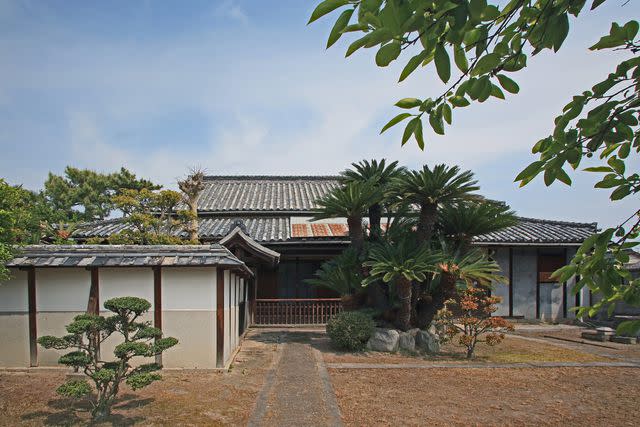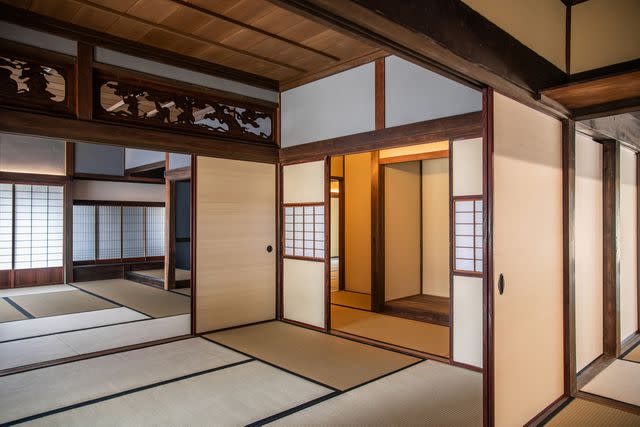This 320-year-old Rural Village Home Was Moved From Japan to California — and You Can Visit in October
The historic Shōya house dates back to about 1700.
A piece of Japanese history is now a part of Southern California’s landscape. The 320-year-old Japanese Heritage Shōya House was meticulously moved from Marugame, Japan, to a two-acre space at The Huntington Library, Art Museum, and Botanical Gardens in San Marino, California. It will welcome visitors on Oct. 21.
The new exhibit will showcase what rural village life was like by spotlighting the 3,000-square-foot home. It will be accompanied by a gatehouse, courtyard, irrigation canal, agricultural plots, and a garden with a pond — all recreated according to historic standards.
“The new Japanese Heritage Shōya House will offer a glimpse into rural Japanese life some 300 years ago and provide insights into that culture and its sustainability practices,” Karen R. Lawrence, The Huntington's president, said in a statement obtained by Travel + Leisure.

© The Huntington Library, Art Museum, and Botanical Gardens
Los Angeles residents Yohko and Akira Yokoi decided to offer their family’s home back in Japan to the institution in 2016. The house belonged to the Yokoi family for generations, as they served as the shōya (village leaders) of a farming community near Marugame in Japan’s Kagawa prefecture. Selected by a feudal lord, the shōya was the liaison between the government and farmers, storing rice, collecting taxes, enforcing the law, and taking responsibility for the planting and harvesting. In essence, “the residence functioned as the local town hall and village square,” The Huntington explained in the release.
In order to properly transport the centuries-old building across the Pacific Ocean, The Huntington’s team traveled to Marugame multiple times to come up with a game plan to recreate an accurate model of what it was like to live inside the home around 1700.
For the last four years, Japanese artisans collaborated with architects, engineers, and construction workers to mindfully recreate the wood and stonework of the building, and the tiling and plasterwork of the roof, paying special attention to honor the cultural traditions.
What stands out now is the dedication to sustainably back then. “An authentically constructed Japanese house using natural materials, combined with careful attention to agricultural practices, will demonstrate how a community became self-sufficient,” said Robert Hori, The Huntington’s cultural curator and programs director. “We will show how emphasis was placed on reducing waste and repairing items so they could be reused or repurposed.”
He added the house will serve as a “working model of Edo period permaculture and regenerative agriculture” as the 18th-century village “maintained a symbiotic relationship between humans and the surrounding landscape.”

© The Huntington Library, Art Museum, and Botanical Gardens

© The Huntington Library, Art Museum, and Botanical Gardens
When it opens in the fall, visitors to the Shōya House will first pass through a persimmon, citrus, and mulberry tree orchard and a black clay roof tiled gatehouse before arriving in the courtyard, which served as a space to celebrate life events, like weddings, funerals, and other celebrations. They’ll then come to two entryways — one of which was used for samurai and government officials and the other for farmers and craftspeople.
Inside the multi-floored home are front rooms used for ceremonial and business purposes, upper floors for honorable guests, and the back portion where the family spent their day-to-day lives with a kitchen, dining space, and bedrooms. The home is decked out in traditional furnishings of the era, including tatami mats and carved wood panels called ranmas.
The new site will be a part of The Huntington's 130-acre botanical garden’s Japanese Garden, which has been part of the site for more than a century. Already on site is a five-room Japanese house that was shipped from the Asian nation to Pasadena, California, around 1904 — and was most recently renovated in 2011. Also in the garden are a ceremonial teahouse, bonsai collection, and Zen court.
While The Huntington is open every day except Tuesday from 10 a.m. to 5 p.m., the Shōya House will only be open from noon to 4 p.m. Note that reservations will be required for Friday to Sunday visits, as well as on holiday and peak days. For more details, visit huntington.org.
For more Travel & Leisure news, make sure to sign up for our newsletter!
Read the original article on Travel & Leisure.

